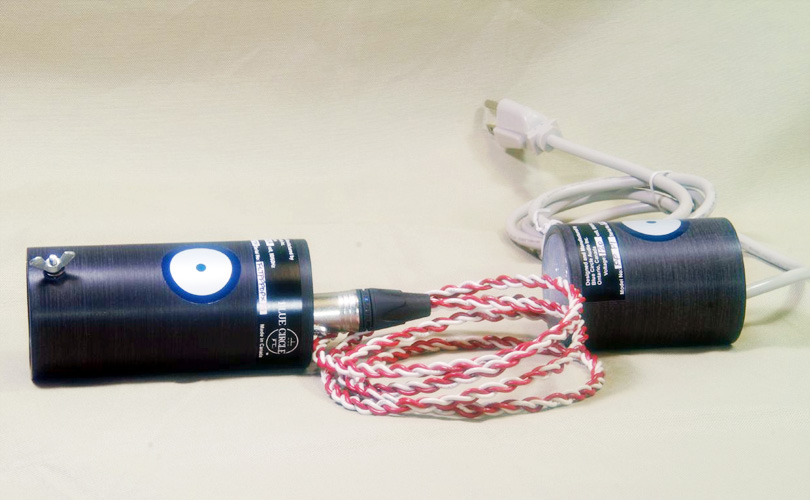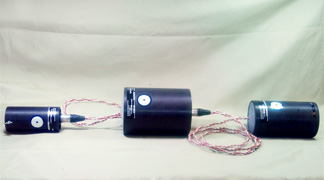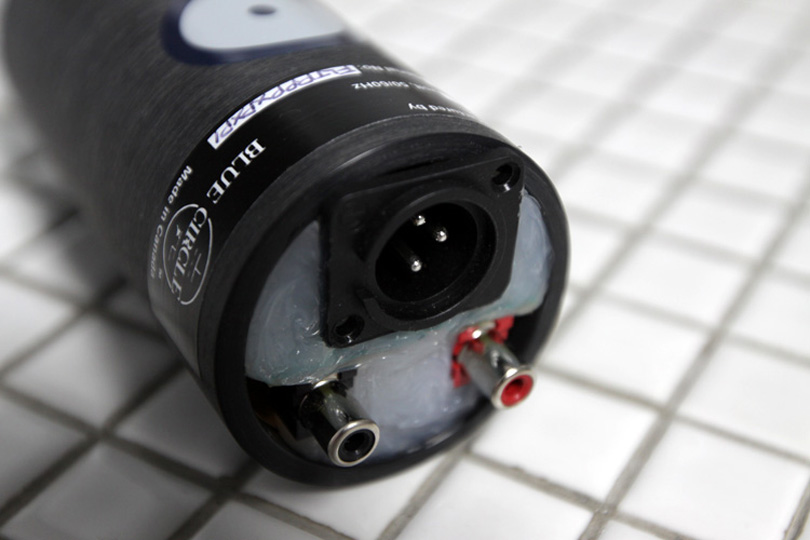September 1, 2009Blue Circle Audio Fon Lo
Thingee Phono Stage
Saying it, I feel like a broken record --
appropriate, considering that the subject of this review is a phono stage -- but Gilbert
Yeung, the man behind Blue Circle Audio, is almost ridiculously pragmatic. In speaking
with him, as well as in hearing and seeing his products, it’s clear that his No.1
priority is obtaining the best sound; any cosmetic appeal comes in a distant second.
Although the functions and appearance of most Blue Circle products can be upgraded, in
their basic configuration they usually boast few bells or whistles.
So it is with Yeung’s newest phono stage, the Fon Lo
Thingee. First, to state the obvious: the Fon Lo Thingee is not pretty. Of the three Blue
Circle products I’ve now reviewed, it’s the least attractive, and the first that
I didn’t want to display on my equipment rack. That said, the FLT isn’t really
meant to be seen. It consists of two small cylinders, one containing the phono gain stage
itself, the other the power supply. There’s no good way to display them; they lie on
their sides.
The Fon Lo Thingee is actually a combination of two other
Blue Circle phono stages: the input stage of the BC703 ($6995 USD) and the output stage
and RIAA equalization of the BC707 ($2295) -- a good example of the benefits to the
consumer of trickled-down technology. The FLT comes in four flavors, ranging in price from
$349 to $949. In all four configurations the gain stage is the same; the various options
are for the power supply. The basic gain stage and power supply cost $349; it can be
upgraded with the Biggie Pipe power supply, which costs another $200 and yields an
additional 88,000uF of capacitance. To the basic power supply or Biggie Pipe can be added
an SP Capacitor pack ($400), which provides more than three times the capacitance of the
Biggie Pipe and is inserted between the power and gain stages, bringing the total cost to
$749 or $949, depending on the power supply selected. With the SP Capacitor in the chain,
the FLT consists of three short lengths of pipe linked with cables colored and striped
like candy canes and terminated in Neutrik connectors. These XLR-style DC power
connections are easily the nicest I’ve used; locking tightly in place, they
can’t be accidentally pulled apart.
There are four jacks on the FLT’s input end: two RCA
connectors and two for loading plugs. Although I never made use of this feature, the
loading plugs let the user match various cartridges with impedances and/or capacitances
(Blue Circle also offers various optional resistance and/or capacitance loading plugs).
User-adjustable gain settings between 60 and 38dB are selected with a small blue DIP
switch located among the four jacks; a wing nut on the top of the phono stage serves as a
grounding post for the turntable ground.
If you use a low-output moving-coil cartridge, you may want
to consider the Fon Lo Thingee MC. It uses the same circuit and comes in the same four
configurations as the FLT, but has user-adjustable gain settings of 58 and 71dB, and is
intended for cartridges with outputs of less than 0.5mV. Owing to the FLT MC’s higher
gain, Blue Circle recommends pairing it with the Biggie Pipe power supply, though that
isn’t absolutely necessary. The FLT MC and its various power-supply configurations
each cost an additional $25 over the prices quoted above, for a range of $374 to $974.
The material used for the FLT’s casework is actually
ABS plastic, which, according to Yueng, is quite sturdy. It’s possible to look
directly inside the FLT and see the circuitry, although a silicone filling conceals the
interior of the power supplies and the SP Capacitor pack.
Recently, Blue Circle has added the option of a battery
pack, the Batche Thingee, though this did not accompany my review sample. Their goal was
to remove the FLT from the power grid, making it immune to fluctuations in the quantity
and quality of power coming from the wall. The Batche Thingee is inserted between the
power supply and gain stage and requires 12 standard AA Ni-MH batteries. Blue Circle
claims that the Batche Thingee will operate for over 48 hours on a full charge. However,
they recommend using the Auto Mute Thingee with the Batche Thingee, so that the FLT is
automatically shut off just before the batteries are fully drained, to prevent any noise
from damaging your components. However, with the Auto Mute Thingee in the chain, a full
battery charge will last only about 20 hours.

The Fon Lo Thingee with the standard power supply.
System
I used the Fon Lo Thingee with a Thorens TD-160HD turntable
fitted with a modified Rega RB250 tonearm, on which was mounted a Dynavector DV-10x5
high-output moving-coil cartridge. Amplification duties were performed by a Bryston B100
SST, to which were connected PSB Platinum M2 bookshelf speakers, via AudioQuest Type 4
speaker cables terminated in banana plugs. The turntable was also connected to the FLT
using AMX Optimum RCA interconnects, while the FLT linked to the Bryston using the phono
cables supplied with the Thorens. All electronics were plugged into an ExactPower EP15A
power conditioner.
Sound
After spending many hours listening to records with the
FLT, it was pretty clear that it had little personality of its own. It refused to lean in
any particular direction, never sounding too bright or too dark, too forward or too
recessed, too lean or too full. It would have been fun to compare the FLT in its base
configuration against more expensive phono stages in a double-blind test. The logistics of
blind testing with vinyl are tricky, but I’d be willing to bet that the FLT would
hold its own well, especially when its price is taken into consideration.
Even with the basic power supply and no capacitor pack, the
Blue Circle sounded superb. If you’re considering buying the FLT, can’t afford
one of its more extravagant power supplies, but are concerned you’ll then get only a
fraction of its performance, stop worrying. Most of the FLT’s performance costs $349
-- don’t expect the improvement in sound to increase proportionately with the
upgrades. This is a phono stage for the audiophile on a budget, and rest assured: this is
an audiophile’s phono stage.
More than anything else, the FLT was musical. I can hear
you asking right now: Isn’t anything that plays back music
"musical"? Strictly speaking, yes. What I mean is that the FLT wasn’t
overly analytical. It did as good a job as any phono stage I’ve heard at conveying
detail and allowing me to hear into recordings, but never to the point where I found
myself dissecting what I was hearing at the expense of the musical whole. In fact, if I
could say just one thing to describe my time with the FLT, it would be this: Once I’d
plugged it into my system, I just sort of forgot about it. Sometimes, equipment will do
something distracting, such as having a little too much energy up top or poor definition
down low, making it easy to focus on a single element in the sound. Not the FLT. It
sounded well balanced and very engaging.
| Add a Biggie Pipe Blue Circle Audio sent along a complete Fon Lo Thingee, including
the Biggie Pipe power supply and SP Capacitor pack. Although I spent most of the review
period using the FLT in its basic configuration, I also did some listening using the
various power-supply options.

My first experiment was to replace the FLT’s basic
power supply with the Biggie Pipe. The net effect of this exchange was an improvement in
the already impressive tightness of the bass. Listening to "Needle in the Hay,"
from Elliott Smith, the lowest notes on Smith’s acoustic guitar firmed up and
became even clearer than with the basic power supply. I couldn’t hear much difference
higher in the audioband, but while the disparity in performance between the two supplies
was small, it was nonetheless noticeable. Overall, the basic PS provided most of the
Biggie’s performance; but if you can swing an extra $200, upgrading to a beefier
power supply is generally a good thing in sound reproduction.
I then returned to the basic power supply, and spent some
time listening to the first few songs from Radiohead’s Kid A (LP, EMI LC0299)
before inserting the SP Capacitor pack in the chain. The first thing I noticed was that
music now appeared from across an even wider stage, on which it was even easier to make
out what was going on. The sound picture was very transparent, images carved out by an
even finer blade, which made them more distinct from everything else around them. On its
own, the FLT sounded very clean; with the SP Capacitor pack, it sounded even cleaner.
As I found out by playing around with different
configurations, even better performance could be had with the improved power supply and
capacitor pack. But when either the Biggie Pipe or the SP Capacitor pack upgrade was added
on its own, the difference wasn’t proportionate to the cost. When I combined them,
however, the improvement over the basic model was quite noticeable.
Again, $349 buys most of the performance the FLT offers,
but a fully decked-out FLT sounded amazingly clear, with an even tonal balance and an
excellent ability to resolve detail. In short, the Blue Circle Audio Fon Lo Thingee is the
best phono stage I’ve heard. If your wallet can stretch far enough, an audition is
absolutely necessary.
. . . Philip Beaudette |
|
|
The pace and rhythm of "Southern Belle," from
Elliott Smith’s self-titled second record (LP, Kill Rock Stars KRS 246), were
invigorating. The music sounded full as Smith’s guitar drove the track forward with
incredible energy. The separation of Smith’s voice and guitar was beyond reproach, as
were the width of the stage and the very natural sense of depth that are hallmarks of
analog sound. This was also true of "Pale Blue Eyes," from the Velvet
Underground’s self-titled third album (LP, MGM SE-4617). The tambourine that emerges
from well behind Lou Reed’s voice creates an illusion of depth in which the ringing
of the instrument’s small metal zils was reproduced with pristine clarity.
It wasn’t only the FLT’s presentation of depth
that was so impressive. "All Is Full of Love," from Björk’s Homogenic
(LP, Björk Overseas Ltd./One Little Indian Ltd. LC 00309), was so immersive that it not
only filled the front of the room but spread out and wrapped itself around me in the
process. Talk about involving. Obviously, the FLT needed good partnering equipment to
achieve this effect, but what was most remarkable was that, even when used in a system
costing many multiples of its price, it didn’t feel out of place. At just $349, most
people are willing to accept sonic shortcomings as part of the package, but I consistently
found there was no need to make any excuses for the FLT’s performance.
Midrange purity was another of the Fon Lo Thingee’s
strengths. Voices consistently impressed me with their clarity, and the sheer ease with
which they were reproduced. Portishead’s newest album, Third (LP,
Island/Universal LC 00407), provided a nice example of this. Singer Beth Gibbons’
dreamlike, reverb-soaked voice was sublime, at times occupying cavernous spaces in which
the calm and control of her voice were a bit haunting. The stage was enormous; the walls
of my listening room seemed to disappear. But despite its commendable performance, the FLT
never did anything particularly special, merely conveying whatever information was in the
grooves of the record.
Moving on to the title track from Massive Attack’s Protection
(LP, Circa LC 3098), I was amazed by the lucidity with which the Blue Circle produced the
ringing of a triangle. As it emanated from the left side of the stage, the sense of space
around it was highly palpable. The bass on this track was weighty and tuneful (at least
down to the limits of my bookshelf speakers), conveying very good definition and detail.
My only regret was that I couldn’t listen to this album on a pair of floorstanders to
really appreciate its low-end heft.
Like its reproduction of the mids and highs, the Fon Lo
Thingee’s re-creation of low frequencies was balanced and very clean. Unless the
music itself was so recorded, bass was never excessive or bloated, but tuneful and
controlled. "Volcano," from Beck’s Modern Guilt (LP, DGC
B0011630-1), was a good example. There’s some fairly low bass on this track, and
while it went pretty deep in my room, it retained excellent clarity and focus. I
don’t mean to suggest that the FLT sounded "digital"; what was amazing was
its ability to achieve a good balance between the warm, full bass that’s
characteristic of vinyl, and the superb precision and intelligibility generally considered
to be strengths of the Compact Disc.
Blue Circle vs. Bryston
For comparison, I used the phono stage aboard the Bryston
B100 SST integrated amplifier. The Bryston phono stage is a $500 option, which puts it in
direct competition with the FLT. Of course, since the phono stage is built into the B100,
it can’t be used in other systems, as can the FLT.
Both phono stages can be used with moving-magnet or
high-output moving-coil cartridges. The Bryston amplifies the signal from the cartridge
more than the Blue Circle did, which meant that I had to turn up the volume with the FLT
in order to match the Bryston’s output level.
The Bryston and Blue Circle had several things in common.
In terms of creating a credible soundstage, both stages were clearly adept at moving music
outside the boundaries of the speakers and, depending on the quality of the recording,
well beyond the front wall of the listening room. The bass reproduction of both was
terrific, demonstrating admirable control and tangible impact. The fullness of analog bass
was present in spades, but with neither the Blue Circle nor the Bryston did it ever come
across as heavy or plodding.
An example of this could be heard on
"Silverfuck," from the Smashing Pumpkins’ Siamese Dream (LP,
Caroline 1740 070 4 61740 5). Both phono stages reproduced this track’s low
frequencies with excellent definition, making it easy to hear subtle changes in the bass.
This was combined with superb midrange clarity that yielded outstanding vocal delineation.
The Bryston had a slight edge in terms of bass firmness, but this advantage all but
disappeared when I switched out the FLT’s basic power supply with the Biggie Pipe
(see sidebar).
In fact, the more I listened, the more obvious it became
how much these phono stages shared. Mind you, they weren’t cut from identical sonic
cloth. The Bryston sounded a touch brighter, bringing the music slightly forward and
subsequently making it seem more immediate. As a result, low-level details were even
easier to hear, but the difference was small and, once again, highly dependent on the
quality of the recording. And while the Blue Circle was no slouch when it came to handling
deep bass, the Bryston seemed a touch more solid, wielding even stronger control over the
low end.
What was most impressive about the Blue Circle was that I
enjoyed listening to records with it just as much as with the Bryston B100 SST’s
phono stage -- but the FLT costs $150 less, and can be used in other systems. Of the four
phono stages I’ve heard in the past 12 months, the FLT is the only one that I know I
could happily live with if I didn’t already own such a stage. The longer it was in my
system, the less I thought about the Bryston, and the more I simply enjoyed everything the
Fon Lo Thingee did.

See our Blue Circle Audio Fon Lo Thingee photo
gallery.
Conclusion
In a review such as this one, in which I praise a product
for its good value, I always wonder how a company manages such high performance at such
low cost. Not so with Blue Circle Audio’s Fon Lo Thingee. One look at it and
there’s absolutely no question where costs have been trimmed. In fact, the FLT’s
biggest problem could be that many potential buyers won’t give it the time of day
because it doesn’t look "high-end" enough. Too bad for them. Appearances
can be deceiving, and that applies here.
But those willing to get past the Fon Lo Thingee’s
no-frills looks to just hear how good it sounds might be rewarded: the performance of
their systems might be taken to the next level for very little money. This unusual-looking
little component is the best-sounding bit of budget hi-fi I’d heard in a very long
time -- an exceptional value. The Fon Lo Thingee might not look like much, but it sounds
like a million bucks.
. . . Philip Beaudette
Price of equipment reviewed
|















